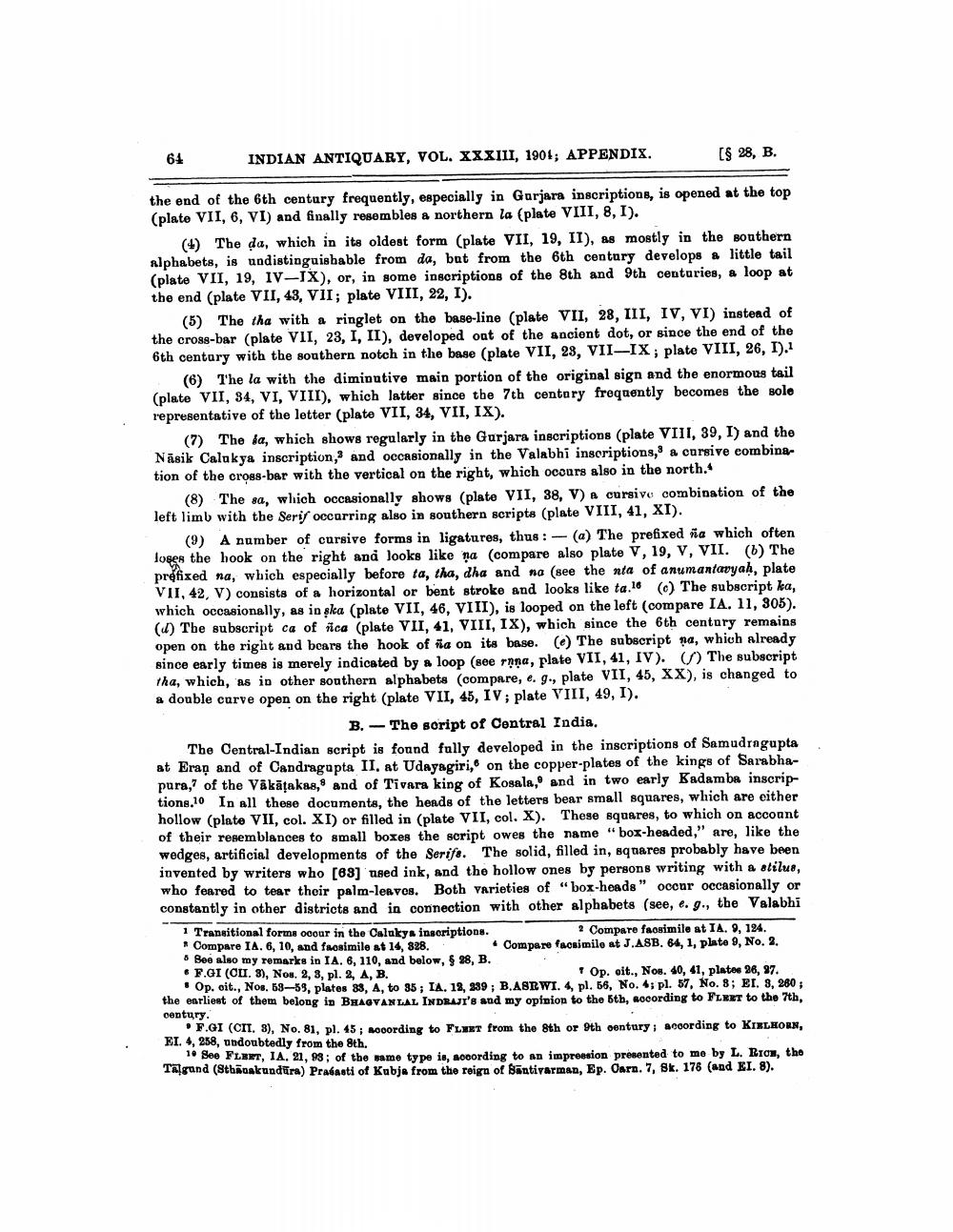________________
64
INDIAN ANTIQUARY, VOL. XXXIII, 1901; APPENDIX.
[$ 28, B.
the end of the 6th century frequently, especially in Gurjara inscriptions, is opened at the top (plate VII, 6, VI) and finally resembles a northern la (plate VIII, 8, 1).
(4) The da, which in its oldest form (plate VII, 19, II), as mostly in the southern Alphabets, is undistinguishable from da, but from the 6th century develops a little tail (plate VII, 19, IV-IX), or, in some inscriptions of the 8th and 9th centuries, a loop at the end (plate VII, 43, VII; plate VIII, 22, I).
(5) The tha with a ringlet on the base-line (plate VII, 28, III, IV, VI) instead of the cross-bar (plate VII, 23, I, II), developed out of the ancient dot, or since the end of the 6th century with the southern notch in the base (plate VII, 28, VII-IX; plate VIII, 26, I).
(6) The la with the diminutive main portion of the original sign and the enormous tail (plate VII, 84, VI, VIII), which latter since the 7th centary frequently becomes the sole representative of the letter (plate VII, 34, VII, IX).
(7) The sa, which shows regularly in the Gurjara inscriptions (plate VIII, 39, I) and the Nasik Calukya inscription, and occasionally in the Valabhi inscriptions, a cursive combination of the cross-bar with the vertical on the right, which occurs also in the north.
(8) The sa, which occasionally shows (plate VII, 38, V) a cursivo combination of the left limb with the Seriy occurring also in southern scripta (plate VIII, 41, XI).
(9) A number of cursive forms in ligatures, thus : - (a) The prefixed na which often loses the hook on the right and looks like na compare also plate V, 19, V, VII. (6) The prefixed na, which especially before ta, tha, dha and na (see the nta of anumantavyah, plate VII, 42, V) consists of a horizontal or bent stroke and looks like ta.16 () The subscript ka, which occasionally, as in ska (plate VII, 46, VIII), is looped on the left (compare IA. 11, 305). (1) The subscript ca of nca (plate VII, 41, VIII, IX), which since the 6th century remains open on the right and bears the hook of ra on its base. () The subscript na, which already since early times is merely indicated by a loop (see rnna, plate VII, 41, IV). The subscript tha, which, as in other southern alphabets (compare, e. g., plate VII, 45, XX), is changed to a double curve open on the right (plate VII, 45, IV; plate VIII, 49, I).
B. - The script of Central India. The Central Indian script is found fully developed in the inscriptions of Samudragupta at Eraņ and of Candragapta II. at Udayagiri, on the copper-plates of the kings of Sarabhapura, of the Väkäțakas, and of Tivara king of Kosala, and in two early Kadamba inscrip tions.10 In all these documents, the bends of the letters bear small squares, which are either hollow (plate VII, col. XI) or filled in (plate VII, col. X). These squares, to which on account of their resemblances to small boxes the script owes the name "box-headed," are, like the wedges, artificial developments of the Serife. The solid, filled in, squares probably have been invented by writers who [89] used ink, and the hollow ones by persons writing with a stilus, who feared to tear their palm-lerves. Both varieties of "box-heads" occur occasionally or constantly in other districts and in connection with other alphabets (see, e.g., the Valabhi 1 Tranzitional forms occur in the Calakya inscriptions.
? Compare frosimile at IA. 9, 194. * Compare IA. 6, 10, and frosimile at 14, 828.
Compare facsimile at J.ASB. 64, 1, plate 8, No. 2. * See also my remarks in IA. 6, 110, and below, $ 98, B. • F.GI (CLI. 3), Nou 2, 3, pl. 2 A, B.
+ Op. cit., Nov. 40, 41, plates 26, 97. Op. oit., Nos, 58-59, plates 33, A, to 35; IA, 18, 389; B.ASRWI. 4 pl. 56, No. 4, pl. 57, No. 8; EL. , 260 the earliest of them belong in BHAGVANLAL INDRAJI's and my opinion to the 6th, according to Flext to the 7th, century.
F.GI (CIT. 8), No. 81, pl. 45 ; According to Fleet from the 8th or 9th century according to KIELHORN, EI. 4, 258, undoubtedly from the 8th.
1 Seo FLEXT, IA, 21, 93 ; of the same type io, according to an impression presented to me by L. Rion, the Tagund (8th onkundra) Prabanti of Kubia from the reign of Bantivarman, Ep. Oarn. 7, Bk. 176 (and KI. 8).




